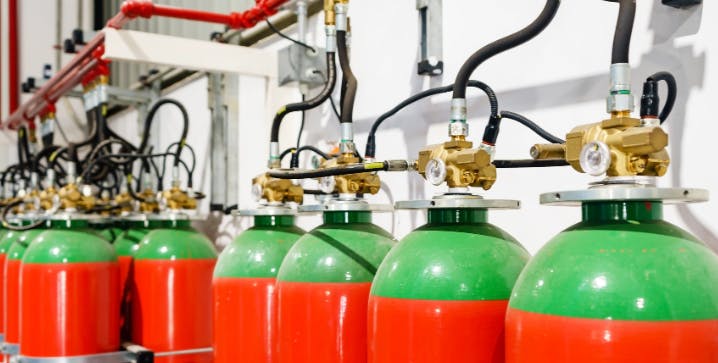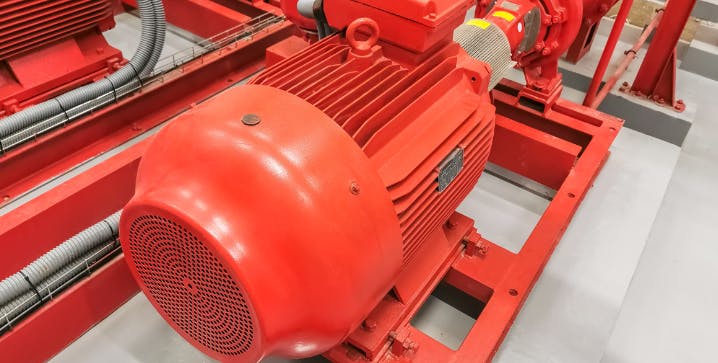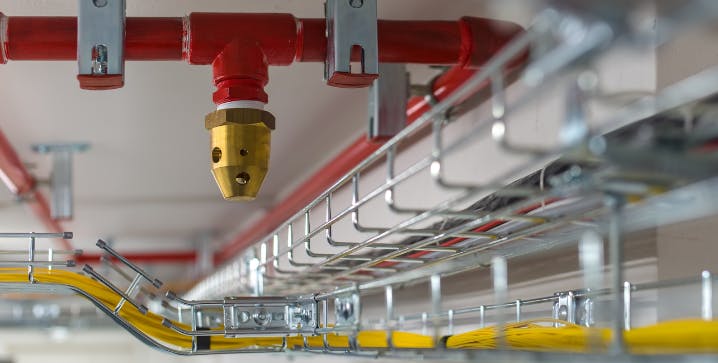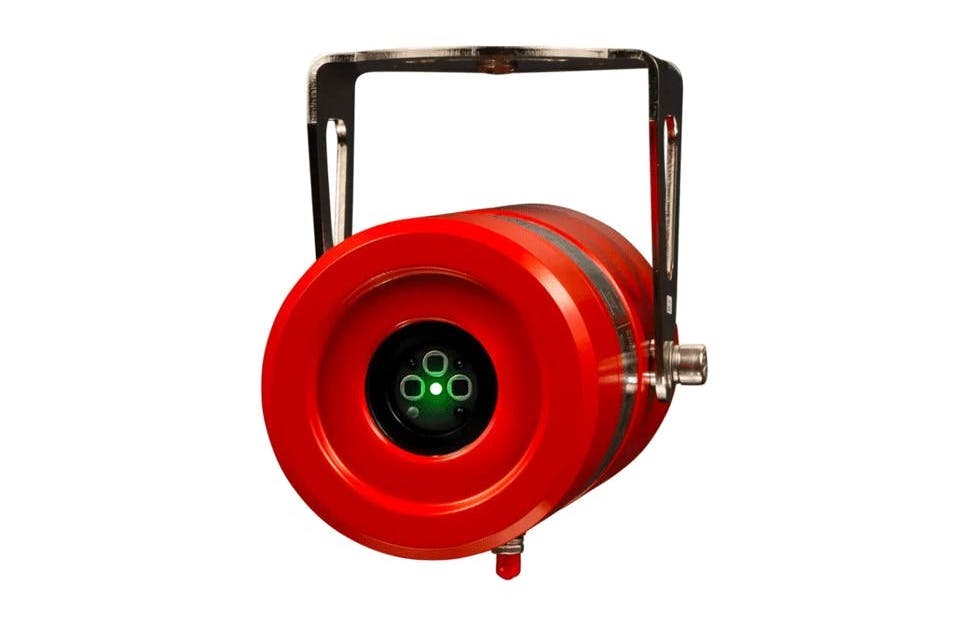Fixed Fire Detection And Protection Systems

What are Fire Detection & Protection Systems?
A fire detection system is a network of sensors and devices designed to detect and alert people to fire in an area or a building. Frontline Safety's Fixed Gas and Fire Project Team can build a system to suit the specifics of your workplace. These typically include smoke detectors, heat detectors and alarms that can be activated manually or automatically.
A typical scenario may comprise a control panel, several conventional smoke detectors, linear heat detection cables, sounders and alarm systems. A conventional smoke detector can be interconnected with several other detectors to pick up smoke and trigger an alarm. Depending on your application and type of building, Frontline Safety can provide conventional or addressable alarm systems. We have experience providing these for industrial and large commercial applications, from office and administration buildings to pharmaceutical and petrochemical processing plants.
Fire protection systems refer to a set of measures and equipment designed to prevent and manage fire disasters. These systems are installed in buildings, factories, and other facilities to protect people and property from fire damage. Some common fire protection systems include fire alarms, sprinkler systems, fire extinguishers, smoke detectors, and fire suppression systems (see below for more information). Overall, fire protection systems are essential for ensuring people's and property's safety during a fire. By quickly detecting and suppressing fires, these systems can help prevent the loss of life and property damage from a fire. Our team are experts in their field and are trained in supplying and installing some of the industry's biggest fire detection and protection providers.
Contact our team today by calling 0141 771 7749, emailing [email protected] or completing the enquiry form below.
Speak to a specialist
Want to know more?
How Can Frontline Safety Help?
We can offer a range of bespoke services to support the design, installation and commissioning and servicing of Fixed Fire Detection Systems. Read on to find out more.
What are Suppression Systems?
Suppression systems are fire protection systems that use agents such as foam, water or chemicals (like gas) to suppress or extinguish fires. A suppression system is beneficial for applications where traditional water sprinkler systems, such as data information centres, telecommunication rooms and areas with electrical cabinets, cannot be used. Frontline Safety can offer bespoke systems, and our team of project engineers will be able to engineer a solution for you and your application.

Gas Suppression Systems
A gas suppression system is a type of fire suppression system that uses inert gases or chemicals to extinguish fires. Unlike traditional water-based fire suppression systems, which can damage sensitive equipment, gas suppression systems quickly and effectively extinguish fires while minimizing damage to the protected area and its contents.
The system works by detecting a fire using smoke or heat detectors. Once a fire is detected, the gas suppression system will release a predetermined amount of gas into the protected area. The gas works by reducing the oxygen concentration in the air to a level where combustion can no longer occur. This quickly extinguishes the fire without causing harm to people or property.
Gas suppression systems are commonly used in areas where traditional fire suppression systems are unsuitable, such as data centres, museums, and hospitals. They are also used in areas where immediate evacuation is not feasible, such as
underground tunnels or storage facilities. A gas suppression system is a safe, effective and reliable way to protect people and property from fires.
What type of Gas Suppression Systems are available?
INERT GAS - Removes oxygen from the fire
Inert Gas fire suppression systems, sometimes called "Clean Agent" systems, use naturally occurring gases (predominantly Nitrogen and Argon) to reduce Oxygen levels within a protected space to such an extent that the atmosphere no longer supports combustion. A popular choice for inert gas fire suppression systems is IG55, a 50% Argon / 50% Nitrogen mix. IG55 is a clean, odourless, and electrically non-conductive gas ideal for use in areas containing sensitive electrical/electronic equipment. Inert gas systems can be considered an environmentally responsible choice for fire suppression systems as IG55 has zero Ozone depletion and zero global warming potential and leaves no residue that would necessitate an extensive post-discharge clean-up operation.
Typical applications include computer, telecommunication and switchgear rooms and electrical cabinets.
HALOCARBON GASES - prevent the chemical reaction of combustion from occurring
Using Halocarbon Gases as a suppression system can prevent the chemical reaction of combustion from occurring. Fast extinguishing flames through Halocarbon Gas is crucial, but this is also costly compared to other suppression systems.
Typical applications include computer, telecommunication and switchgear rooms and electrical cabinets.
CARBON DIOXIDE (CO2) - removes Oxygen from the fire
Carbon Dioxide (CO2) has a density greater than air, so it can suppress a fire by removing the Oxygen (O2) a fire requires to burn. This suppression system can be used as a 'local system,' meaning it will apply CO2 directly onto whatever is burning. Something to note with this system is that carbon dioxide cannot be used when personnel are present. However, we can ensure several safeguarding measures are used to prevent accidental discharge when these spaces are occupied.
Typical applications include unoccupied electrical switchgear rooms, gas turbines and machinery space.
HYPOXIC SYSTEM remove Oxygen from the protected space to prevent combustion from occurring
A Hypoxic system works to remove oxygen from a protected area to prevent combustion from occurring. This system is commonly seen in applications such as libraries or archive stores and can be used whilst allowing personnel to continue working in
the room without any health risks.
Typical applications include libraries and archive stores.

What are Foam Suppression Systems?
Foam suppression systems effectively suppress fires and smother the flames, preventing Oxygen (O2) from reaching them. They are commonly used in industrial settings where flammable liquids, such as hydrocarbon fuels, may be at risk of catching fire. One of the benefits of a foam suppression system is that it can cover large areas quickly due to its expansion properties. There are different types of foam suitable for specific flammable properties, which our team can help to explain once your needs are communicated.

What are Water Suppression Systems?
A water suppression system comprises small water droplets to create a mist. These mists simultaneously cool fire and reduce the Oxygen to prevent combustion from occurring. The water mist can be carried through a network of pipes, valves and sprinkler heads placed throughout a building or facility. The water is released onto the affected area to extinguish the flames. An advantage of water mist suppression over a traditional sprinkler system is can reach an increased surface area. It's mostly suitable for applications involving machinery, power generation turbines and transportation.
BROWSE OUR LIBRARY OF APPLICATION NOTES & CASE STUDIES IN OUR SAFETY CENTRE

APPLICATION NOTES
Choose from a range of application notes that cover various industries and hazards.

SAFETY CENTRE
Access a wealth of knowledge in our Safety Centre, including helpful blogs and product guides
Shop Flame Detectors at Frontline Safety
Our Suppliers
We offer a range of fixed gas detection systems with several sensors, components and accessories from some of the industry's biggest manufacturers.
Browse our website for more information on our products, including datasheets.
CONTACT US TODAY FOR A FULL CONSULTATION AND REVIEW OF YOUR CURRENT SYSTEM. EITHER COMPLETE THE FORM BELOW OR CALL US NOW ON 0141 771 7749.
Contact our specialists
Our dedicated team of Service and Project Engineers have a range of expertise and knowledge and are on hand to discuss your fixed fire and gas detection needs.














